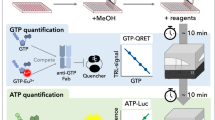Abstract
Oxidative stress plays a crucial role in DNA and RNA damage within biological cells. As a consequence, mutations of DNA can occur, leading to disorders like cancer and neurodegenerative and cardiovascular diseases. The oxidative attack of guanosine and 8-oxo-7,8-dihydroguanosine is simulated by electrochemistry coupled to capillary electrophoresis–mass spectrometry. The electrochemical conversion of the compound of interest is implemented in the injection protocol termed electrochemically assisted injection (EAI). In this way, oxidation products of guanosine can be generated electrochemically, separated by capillary electrophoresis, and detected by electrospray ionization time-of-flight mass spectrometry (EAI–CE–MS). A fully automated laboratory-made EAI cell with an integrated buffer reservoir and a compartment holding screen-printed electrodes is used for the injection. In this study, parameters like pH of the sample solution and the redox potential applied during the injection were investigated in terms of corresponding formation of well-known markers of DNA damage. The important product species, 8-oxo-7,8-dihydroguanosine, was investigated in a separate study to distinguish between primary and secondary oxidation products. A comparison of product species formed under alkaline, neutral, and acidic conditions is presented. To compare real biological systems with an analytical approach for simulation of oxidative stress, it is desirable to have a well-defined control over the redox potential and to use solutions, which are close to physiological conditions. In contrast to typical HPLC–MS protocols, the hyphenation of EAI, CE, and MS enables the generation and separation of species involved without the use of organic solvents. Thus, information of the electrochemical behavior of the nucleoside guanosine as well as the primary oxidation product 8-oxo-7,8-dihydroguanosine can be characterized under conditions close to the physiological situation. In addition, the migration behavior found in CE separations of product species can be used to identify compounds if several possible species have the same mass-to-charge values determined by MS detection.

ᅟ





Similar content being viewed by others
Abbreviations
- 5-OH-8-oxo-Gs:
-
5-Hydroxy-8-oxo-7,8-dihydroguanosine
- 8-Oxo-Gs:
-
8-Oxo-7,8-dihydroguanosine
- BDD:
-
Boron-doped diamond
- Caf:
-
Caffeine
- CE:
-
Capillary electrophoresis
- dGh:
-
Dehydroguanidinohydantoin
- dGMP:
-
2′-Deoxyguanosine-5′-monophosphate
- EAI:
-
Electrochemically assisted injection
- EC–MS:
-
Electrochemistry–mass spectrometry
- EC–μLC–MS:
-
Electrochemistry–μ-liquid chromatography–mass spectrometry
- EOF:
-
Electroosmotic flow
- ESI-Tof-MS:
-
Electrospray ionization time-of-flight mass spectrometry
- Gh:
-
Guanidinohydantoin
- Gs:
-
Guanosine
- Ip:
-
Diiminopyrimidinone
- Iz:
-
Imidazolone
- LC–MS:
-
Liquid chromatography–mass spectrometry
- MS:
-
Mass spectrometry
- NH4OAc:
-
Ammonium acetate
- Ox:
-
Oxadiazine
- Q-Tof-MS:
-
Quadrupole time-of-flight mass spectrometry
- ROS:
-
Reactive oxygen species
- Sp:
-
Spiroiminodihydantoin
- SPCE:
-
Screen-printed carbon electrode
- t m :
-
Migration time
References
Burrows CJ, Muller JG (1998) Chem Rev 98:1109. doi:10.1021/cr960421s
Wang D, Kreutzer DA, Essigmann JM (1998) Mutat Res 400:99. doi:10.1016/S0027-5107(98)00066-9
Kamiya H (2003) Nucleic Acids Res 31:517. doi:10.1093/nar/gkg137
Broedbaek K, Weimann A, Stovgaard ES, Poulsen HE (2011) Free Radic Biol Med 51:1473. doi:10.1016/j.freeradbiomed.2011.07.007
Dryhurst G, Elving PJ (1969) Talanta 16:855. doi:10.1016/0039-9140(69)80126-8
Oliveira-Brett AM, Matysik F-M (1997) Bioelectrochem Bioener 42:111. doi:10.1016/S0302-4598(96)05123-9
Baumann A, Lohmann W, Jahn S, Karst U (2010) Electroanalysis 3:286. doi:10.1002/elan.200900358
Boussicault F, Robert M (2008) Chem Rev 108:10.1021/cr0680787
Mautjana NA, Looi DW, Eyler JR, Brajter-Toth A (2009) Electrochim Acta 55:52. doi:10.1016/j.electacta.2009.07.083
Keniry MA (2001) Biopolymers 56:123. doi:10.1002/1097-0282(2000/2001)56:3<123::AID-BIP10010>3.0.CO;2–3
Pitterl F, Chervet J-P, Oberacher H (2010) Anal Bioanal Chem 397:1203. doi:10.1007/s00216-010-3674-z
Erb R, Plattner S, Pitterl F, Brouwer H-J, Oberacher H (2012) Electrophoresis 33:614. doi:10.1002/elps.201100406
Matysik F-M (2003) Electrochem Commun 5:1021. doi:10.1016/j.elecom.2003.10.001
Scholz R, Matysik F-M (2011) Analyst 136:1562. doi:10.1039/C0AN00794C
Lopes FS, Antunes O, Gutz IGR (2010) Electrochem Commun 12:1387. doi:10.1016/j.elecom.2010.07.027
Santos MSF, Lopes FS, Vidal DTR, do Lago CL, Gutz IGR (2012) Anal Chem 84:7599. doi:10.1021/ac30193121
Palatzky P, Matysik F-M (2012) Electrophoresis 33:2689. doi:10.1002/elps.201200088
Palatzky P, Zöpfl A, Hirsch T, Matysik F-M (2013) Electroanalysis 25:117. doi:10.1002/elan.201200393
Markus TZ, Daube SS, Naaman R, Fleming AM, Muller JG, Burrows CJ (2009) J Am Chem Soc 131:89. doi:10.1021/ja804177j
Steenken S, Jovanovic SV (1997) J Am Chem Soc 119:617. doi:10.1021/ja962255b
Pratviel G, Meunier B (2006) Chem Eur J 12:6018. doi:10.1002/chem.200600539
Goyal RN, Sondhi SM, Latoti AM (2005) New J Chem 29:587. doi:10.1039/b415452p
McCallum JEB, Kuniyoshi CY, Foote CS (2004) J Am Chem Soc 126:16777. doi:10.1021/ja030678p
Verdolino V, Cammi R, Munk BH, Schlegel HB (2008) J Phys Chem B 112:16860. doi:10.1021/jp8068877
Fleming AM, Muller JG, Dlouhy AC, Burrows CJ (2012) J Am Chem Soc 134:15091. doi:10.1021/ja306077b
Ye Y, Muller JG, Luo W, Mayne CL, Shallop AJ, Jones RA, Burrows CJ (2003) J Am Chem Soc 125:13926. doi:10.1021/ja0378660
Niles JC, Wishnok JS, Tannenbaum SR (2006) Nitric Oxide 14:109. doi:10.1016/j.niox.2005.11.001
Sheu C, Kang P, Khan S, Foote CS (2002) J Am Chem Soc 124:3905. doi:10.1021/ja011696e
Kang P, Foote CS (2002) J Am Chem Soc 124:4865. doi:10.1021/ja012038x
Volk KJ, Lee MS, Yost RA, Brajter-Toth A (1988) Anal Chem 60:720. doi:10.1021/ac00158a025
Volk KJ, Yost RA, Brajter-Toth A (1992) Anal Chem 64:21A. doi:10.1021/ac00025a721
Müller H, Carell T (2007) Eur J Org Chem 2007:1438. doi:10.1002/ejoc.200600982
Murakami H, Esaka Y, Nakayama T, Uno B (2011) Chem Lett 40:268. doi:10.1246/cl.2011.268
Acknowledgments
This research was supported by the Research Executive Agency (REA) of the European Union under grant agreement number PITN-GA-2010-264772 (ITN CHEBANA). We thank J. Kiermaier for the measurements concerning high-resolution mass spectrometry.
Author information
Authors and Affiliations
Corresponding author
Rights and permissions
About this article
Cite this article
Scholz, R., Palatzky, P. & Matysik, FM. Simulation of oxidative stress of guanosine and 8-oxo-7,8-dihydroguanosine by electrochemically assisted injection–capillary electrophoresis–mass spectrometry. Anal Bioanal Chem 406, 687–694 (2014). https://doi.org/10.1007/s00216-013-7500-2
Received:
Revised:
Accepted:
Published:
Issue Date:
DOI: https://doi.org/10.1007/s00216-013-7500-2




